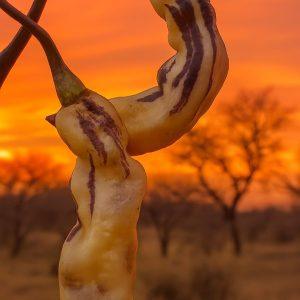Description
Cultivar Name: Cherry Bomb Pepper Seeds
Species: Capsicum annuum
Common Names: Cherry Bomb, Hot Cherry Pepper
Type: Hybrid (Cerasiforme Group)
Origin & Lineage
Geographic Origin: United States (selectively bred from Central and South American landraces)
Development History: The Cherry Bomb pepper was developed in the U.S. through selective breeding to combine disease resistance, early maturity, and culinary versatility. It belongs to the Cerasiforme Group of Capsicum annuum, which includes other round, cherry-shaped cultivars like pimentos and Hungarian cherry peppers. Though its exact breeder remains undocumented, its popularity surged in the 20th century as a home garden staple and pickling favorite.
Cultural Significance: Cherry Bomb peppers have become synonymous with stuffed appetizers and pickled condiments. Their thick walls and sweet heat make them ideal for cheese-stuffed poppers, deli-style pickled peppers, and barbecue sides. In European and American kitchens, they are often mistaken for pimentos, yet they deliver a more assertive heat and crunch.
Lineage / Hybridizer History:
While not attributed to a single hybridizer, the Cherry Bomb emerged from breeding programs focused on improving the culinary traits of cherry-shaped peppers. Its lineage includes sweet cherry peppers and mild annuum cultivars, refined for uniformity, yield, and flavor.
Heat Profile
Scoville Rating (SHU):
2,500–5,000 SHU
Perceived Heat:
Mild to medium—comparable to a jalapeño
Heat Characteristics:
The heat is gentle and approachable, making it ideal for those new to spicy food. It begins with a subtle warmth that builds slightly, never overwhelming the palate. The burn is concentrated in the seeds and membranes, but the thick flesh tempers the intensity. When pickled, the heat mellows further, offering a tangy kick.
Flavor Profile
Tasting Notes:
Cherry Bomb peppers are prized for their sweet, juicy flesh. The flavor is reminiscent of ripe cherry tomatoes with a hint of apple and mild spice. When fresh, they offer a crisp bite and a clean finish. Roasting or grilling enhances their natural sugars, adding depth and caramelized notes.
Aftertaste / Finish:
The finish is slightly tangy with a lingering sweetness. Pickled Cherry Bombs develop a bright, vinegary snap, while stuffed versions absorb savory flavors from cheese, meat, or herbs.
Ideal Pairings:
- Cream cheese and sausage-stuffed poppers
- Pickled sides for barbecue and deli platters
- Roasted pepper antipasti
- Sweet-and-spicy chutneys
- Cherry Bomb BBQ sauce or hot sauce blends
Pod Review: https://www.youtube.com/watch?v=54BjKDattLU
Fruit Characteristics
- Shape: Round to slightly ovate, cherry-like
- Size: 2–3 cm diameter, 2 inches long
- Color Stages: Immature: green → Ripe: bright red
- Wall Thickness: Thick
- Texture & Skin: Smooth, glossy, firm
Plant Details
- Growth Habit: Compact and bushy
- Plant Height & Width: 45–60 cm tall, 30–45 cm spread
- Foliage: Green, lanceolate leaves
- Flower Color: White
- Days to Maturity: 75–85 days from transplant
- Yield: Moderate – 20–40 pods per plant
Cultivation Information
- Seed Count per Pack: 10 seeds
- Germination Time: 7–14 days (Germinating Chilli Seeds)
- Optimal Germination Temp: 24–27°C (Essential guide to ideal temperatures and humidity for chilli seed germination)
- Light Requirements: Filtered sun (6–8 hours/day)
- Soil Preferences:
- pH: 6.0–6.8
- Well-draining loam with compost (Easy DIY soil mixes)
- Avoid waterlogging; mulch to retain moisture
Storage Tips:
Store Cherry bomb pepper seeds in airtight containers in a cool, dry place. Refrigeration with desiccants can extend viability up to 3 years.
Notable Compounds
Capsaicinoid Content:
- Moderate capsaicin levels
- Trace dihydrocapsaicin
Volatile Flavor Compounds:
- Limonene (citrus)
- Vanillin (sweetness)
- Beta-ionone (fruity)
Anthocyanins / Pigments:
Red coloration due to carotenoids; no purple pigmentation
Culinary & Cultural Use
Traditional Uses:
Cherry Bomb peppers are a staple in American and European kitchens. They are frequently pickled, stuffed, or roasted. Their thick walls and mild heat make them ideal for cheese-stuffed peppers, deli-style pickles, and antipasti platters.
Raw vs Cooked Flavor:
Raw peppers offer crisp sweetness and mild spice. Cooking—especially roasting or grilling—intensifies their sugars and adds smoky depth. Pickling introduces acidity and crunch, while stuffing absorbs savory richness.
Regional Dishes:
- Pickled Cherry Bombs with garlic and bay leaf
- Cream cheese and sausage-stuffed poppers
- Cherry Bomb BBQ glaze
- Roasted Cherry Bombs with olive oil and herbs
- Cherry Bomb salsa with tomato and cilantro
Storage / Drying / Preserving Tips:
Pickling is the most popular preservation method. Use vinegar, garlic, and spices to create a tangy brine. For drying, slice and dehydrate at low temperatures. Store in airtight containers away from light. Roasted or grilled peppers can be frozen for later use.






Reviews
There are no reviews yet.